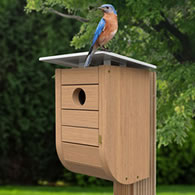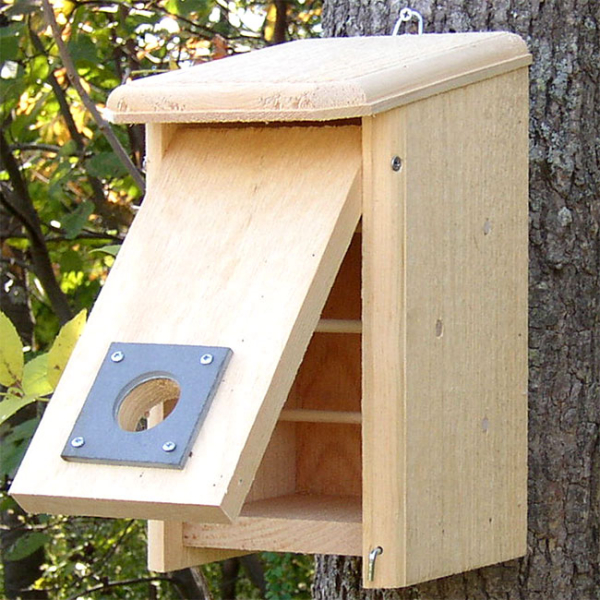
Fall provides an opportunity to maintain and clean nest boxes for next season, and to make them available as a winter roost site. This is a Nordic Habitat Modern Bluebird House, available from Duncraft.

This unique Convertible Bird House/Winter Roost Box, available from BestNest, can be used as a roost box during cold weather, and converted to a nest box during spring and summer.
|
Whether you have one nest box or twenty-one, fall is the best time to get ahead of the curve on maintaining or adding nest boxes, and you definitely want to have a roost box or two in the mix. Whether you specialize in songbird nest boxes, or prefer big nest boxes for screech owls and Wood Ducks – or a mix of big and small birdhouses, beautiful fall weather can be a good motivator to check on your nest boxes. Some birders limit their nest boxes to their yard or property, but some enthusiastic nest box landlords have nest boxes installed along a nest box trail.
Fall is prime time to do some simple “house”keeping, make any repairs, and add a new roost box without the time crunch the spring nesting season can create. Each nest box or birdhouse (both names describe the same thing) should have a hinged panel that allows you to view and access the interior, and it’s a good plan to inspect your nest boxes inside and out before winter. Most birders remove old nests and other material inside the nest box, which is generally a good idea if you want to control mites, blow fly larvae, mice, bees, and other potential mini-invaders.
Autumn is also a good time to make simple repairs; replace a screw, add a nail, fix a hinge; or replace a nest box entirely. You can also improve a nest box by installing a hinged side or front panel so you can properly monitor the use of all nest boxes, and easily clean them at the end of the nesting season. Then too, if a nest box hasn’t been attracting nesting birds you may want to move it to a potentially better location.
Check your predator proofing too, to ensure it is still functional to keep raccoons, snakes, squirrels, chipmunks, and the likes away from your nest box. Predator proofing is absolutely essential to ensure that cavity nesting birds, their eggs, and their nestlings are safe during the period they utilize your nest box.
Roost Boxes
Nest boxes can provide some options for birds during the non-nesting season, because some cavity nesting birds will use a nest box as a roosting location overnight during late fall and winter. This is especially true for owls and woodpeckers, bluebirds, titmice, and chickadees. These birds tend to use the size of box they would use for nesting, but having a roosting screech owl spend time in your nest box is a pretty special experience – one to encourage.
By placing a shallow layer of fresh wood chips in the bottom of a large nest box, you may make it more attractive for roosting birds. Then too, smaller birds such as bluebirds and chickadees are known to utilize a nest box as a communal roost site with several of them huddling together during cold weather, so keep an eye out for any fall or winter action at your nest boxes.
Even better is the addition of one or more Roost Boxes, specially designed as winter roost sites. While a nest box could be used as a winter roosting location, you can also make or buy a focused roost box. These roost boxes have an entrance hole near the bottom of the box, with one or more cross bars installed horizontally to be used as perches. The idea behind having the opening at the bottom of the box is to keep warm air, which rises – created by the bird or birds inside the box – while keeping the warmth from escaping from a nest box entrance hole. The crossbar perches allow a bird or birds to perch above the entrance hole where the warmer air is contained.
A really impressive option is a convertible roost box/nest box, which allows you to reposition the front panel of the box where the entrance hole is positioned. This unique design allows you to position the hole high during the nesting season, then reversing the panel so the hole is low during the cold weather roosting period. We are only aware of one style of “reversible” roost–nest box on the market now, which is made for cavity-using songbirds including bluebirds and chickadees; it’s available from BestNest. Even so, it’s a relatively easy modification to convert any nest box into one with a reversible entrance.
Modifying a nest box into a reversible roost–nest box can be especially useful if you are looking to attract one of the small owls – screech, saw-whet, pygmy, or Boreal Owls – or even larger Barn Owls. Just remove the nails or screws that attach the front panel to the rest of the nest box; flip the front panel upside down, and screw it back into place. (We suggest reinstalling with screws, which should make taking them out and reinstalling them a bit easier.) Once you’ve done this once, you may find an easier or better way to make the flip, but for now, you get the idea – give it a try.
New Birdhouses
Fall is an excellent time to install new nest boxes too. Perhaps you would like to add a big nest box to try to attract a nesting Wood Duck, Hooded Merganser, American Kestrel, or one of the screech owl species next spring. For some birders, attracting a nesting pair of one of the larger cavity nesting birds is an ultimate goal, and it may take some time for these birds to choose your nest box, as is the case with all potential birdhouse residents. Attracting bluebirds, chickadees, and wrens can be just as rewarding, and super-beneficial for these cavity nesting songbirds. You may want to buy a new nest box or two, but make sure any nest box you shop for has a means of opening a side or top to access the inside, and ensure that the entrance hole has the right dimensions for the cavity nesting birds you wish to attract.
On cold weather or rainy days, fall can also a good time to build a new nest box or two. Make it a family project to be shared between parents and children, or grandparents and grandchildren. Teachers and scout leaders may also find building nest boxes a fun and useful project to share with students and scouts. Some nature centers offer nest box or birdhouse building activities, although you can suggest the idea of adding such a project at a local nature center, wildlife refuge visitor center, bird observatory, Audubon chapter, or birding club to name a few of the groups that can initiate project to benefit local populations of cavity nesting birds.
As you know, a lack of natural tree cavities or woodpecker-created cavities is a limiting factor for all species of cavity nesting birds. Then too, a nest box can be a safer nest site than a natural cavity, as long as each nest box has appropriate predator-proofing. To learn more about nest boxes, birdhouses, and cavity nesting birds, a great source of information is NestWatch, which provides a wealth of information and sources for getting started or improving your nest box activities.
You will probably be surprised by all the different kinds of birds you can benefit, and their individual needs regarding nest boxes and nesting structures. Another arm of the Cornell Lab of Ornithology, you can access the wealth of information provided by NestWatch at NestWatch | NestWatch - Where Birds Come to Life And if you are interested in buying a new nest box for Wood Ducks or bluebirds and other cavity nesting birds, check out the impressive variety available from BestNest at BestNest.com: Bird Houses. Buy a Bird House at BestNest.com! including their convertible roost box at Coveside Convertible Bird House/Winter Roost at BestNest.com
Share your backyard birding experiences and photographs with The Birding Wire at editorstbw2@gmail.com